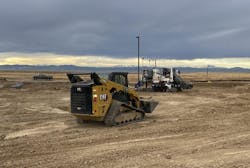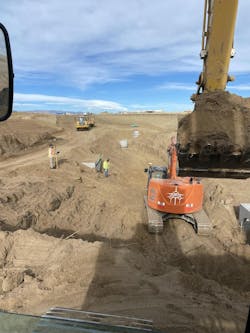“Some days I wear the superintendent hat in the grand scheme of things,” Peters, 26, says. “I’m kind of our concrete division manager. Then I’m our purchasing guy, our acquisitions guy. I’m also a concrete finisher and equipment operator.”
Matt is a member of the 2021 Class of Under 40 in Construction Equipment. Read more here. Click here to nominate a person for the Under 40 awards.
After starting as a landscape company, Solid Earth is now a small- to mid-size heavy civil subcontractor with around 55 employees at peak season.
“We focus on giving our clients the opportunity to purchase an all-inclusive package when it comes to the civil infrastructure package,” Peters says.
That includes concrete drainage infrastructure, utilities, storm, sewer, and water, though the company will do one-offs such as a solo earthmoving or concrete-pouring job. “The only thing we don’t touch is gas,” Peters says. “And [we also do] overlot grading, scraper dirt, structural excavation.”
Solid Earth has a fleet that includes excavators, scrapers, dozers, haul trucks, a 3D curb and gutter machine, and more.
Peters started working for his parents early on. One could say very early on. “I used to sleep on the floor of my mom’s office when I was a kid, and my dad would babysit me in the field. So, our whole family, we’ve grown up around this and it never was shut off. We never shut off the work part. Every day and every night, the conversations were about work. I started in the field at 12 or 13 years old, hot and heavy.
“That was probably before I should have, but I really appreciated that, and that work ethic was instilled pretty early,” Peters says. “To be honest, I’m addicted. I love it. I love what we do. It’s a blast.”
One of the accomplishments Peters is most proud of is introducing machine control to the Solid Earth fleet. It was an improvement he’d been eyeing, but he had to prove its worth to a tough audience—his parents.
“There was skepticism because of the initial investment costs of 3D machine control,” Peters says. “I had a school project and got a hold of a Topcon rep and said, ‘Hey, I want to try this stuff.’ He came out and showed me how to build a quick surface in the field.
“He then walked me through uploading it into a rental John Deere dozer,” Peters says. “And it was not the most professional 3D model by any means. We were topo’ing the stakes out on the job site and building a very rudimentary 3D surface. One night after work, I was trying to get caught up, I was still grading. My dad came out there and I said, ‘Pops, look! No hands!’
“He was watching this dozer grading, and I was just sitting in the seat only steering it, and he was kind of blown away,” Peters says. “I think at that moment, that turned him into a believer, and he thought okay, this stuff is going to work.”
Peters recalls the process wasn’t quite as smooth as it sounds now, looking back.
“I had to stumble through trying to find the equipment and learn it as I was trying to run a project,” he says. “It was one of the most stressful things I can remember being in this industry, trying to balance it all. It was a school project, so you have a super tight deadline before the kids go back to school. I had a new crew, so I was trying to juggle all that. It was worth it, now, but horribly stressful at the time.
“But I’m thankful that it wasn’t a fight to try to convince them, because they saw the productivity instantly,” Peters says. “I mean the proof is in the pudding, right there, in that moment. You can see that this technology works, doesn’t it?”
After affirmation from his father, Peters started to add machine control to equipment piece by piece as Solid Earth could afford to upgrade.
“Even some of the older guys or the skeptics saw the value in it, and we have it integrated into every division,” Peters says. “All of our pipe guys use it. Our pipesetters carry a GPS rover with them, and we’ve since switched to Trimble just because we have a lot of Cat in the fleet and there’s support from Trimble. Especially our Sitech salesman. I can’t even call him a salesman. He is absolutely incredible. He’s been our teacher and mentor through 3D.
“Our pipe guys are checking layouts and we still cross check the old school way with a laser or a sight, but everybody’s using it. There are some issues with it, of course, but that’s what’s nice about those old school guys that know the old school way—it kind of keeps everybody balanced.”
Peters has not yet been able to quantify a dollar savings for the company, but he is quick to cite other benefits.
Top benefits of machine control
“It’s hard enough right now to track the quantities and the buildings that we already have to do, and the analytics that are key to the day-to-day,” Peters says. “So, when it comes to tracking the analytics of physical savings with 3D machine control, I don’t think we have an actual dollar amount, a tangible dollar amount or percentage that we can say, ‘This is what it’s saving us.’
“But when you look at the estimators’ project durations, and when we’re finishing before schedule, or let’s say a project has a ton of change orders and additional work, yet we still finish the project within the original scheduled time—we use things like that to help justify the success of 3D machine control and 3D solutions,” Peters says.
In slipform paving, Solid Earth no longer needs people going out the day before a job to set stringline. It can set up total stations and pave every day without the extra labor expense. Peters says that while it would be nice to have the exact dollar amounts for savings, a lot of it comes down to time.
“You can look at labor costs and savings because of durations being shorter, and machine wear because they are taking fewer passes to grade something,” Peters says. “There are a lot of ways to quantify it. But it’s super apparent that it’s saving potentially hundreds of thousands of dollars a year.”
The journey through machine control implementation has been easier than Peters thought it might be.
“Dirt equipment’s easy, it’s almost foolproof,” Peters says. “To any of the skeptics out there and naysayers—it’s really easy to check between the survey stake and your 3D machine control in dirt equipment. The hardest stuff is paving equipment, because you have one shot to make it right. You don’t get an extra pass, you can’t just back over it and push it again.
“One of the biggest things I can recommend, it’s been a lesson well learned from us internally, is always have great site control,” Peters says. “Have a survey company or engineering firm set that site control. Have some stakes out there. I know people say, ‘Get rid of the stakes.’ But the stakes are just that reassurance to not only your customer, client, or whomever you’re working for, but also to your crews, that the 3D machine control is matching what you’re trying to build.”
Peters says he still has sewer lines staked out with offsets so crews can check job accuracy.
“Those are double checks to ensure that our technology is doing what it’s supposed to, because it usually never comes down to the actual technology being an issue,” Peters says. “It’s still the human factor where the mistakes happen, whether it’s a measure up that’s been done incorrectly or that not enough control was used to calibrate the site.
“But trying to minimize that human error and put some of that liability or that potential for mistakes back on a surveying company that does it professionally and has a bunch of trained field surveyors and engineers will make a company that’s trying to implement 3D, or that already has 3D, that much more successful because those double checks are there,” Peters says.
“I truly don’t believe in just running blind because running 3D is running blind,” Peters says. “You don’t have checks and balances if you’re just running 3D alone. You definitely need that outside staking or control to give yourself assurance that you’re building whatever you’re building correctly.”
How to convince clients to use machine control
Clients themselves can be skeptical about machine control, according to Peters.
“I’m working for a big client now on a lot of tilt-up buildings, and I’m pouring all their site work,” Peters says. “They were very skeptical at first. And then they saw us pour 200 yards of curb one day and they were like, ‘Oh wow. Oh, wow, this really works.’ And that’s a really good curb day. It was close to 4,000 feet of curb, and they were excited. Now they’ve actually sent us work to go across the country to pour more sitework for their buildings.”
The drive that spurred Peters to implement machine control across Solid Earth’s equipment fleet is rooted in his personal philosophy. “I have this constant, I guess you could call it a thirst, for wanting to do things better and more efficiently,” he says. “So much of my time is consumed by thinking and asking, ‘How can this be better?’ You can ask my equipment salesmen and my Sitech salesman and they’ll tell you I’m obsessed with trying to figure out different solutions, whether that’s a small hand tool to help my finishers be more proficient, or whether it is something as big as what type of scraper to go with in our future work. It’s a constant obsession.
“To me, that’s fun,” Peters says. “The challenge is so stimulating that it’s fun. How can we be more efficient? It might sound a little vain, but I love it, it really brings a lot of joy to what I do, the in-the-field aspect. It kind of covers all spectrums of what we’re doing and everything we offer.
“There are times when I won’t go to bed until one or two in the morning because I’m trying to figure out a better way to pull a disc than using an ag tractor because we’ve had horrible luck with all manufacturers of ag tractors,” Peters says. “It’s really a constant obsession.”







